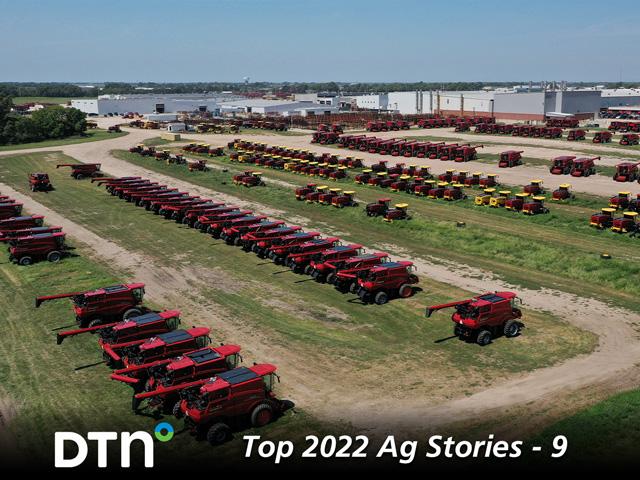Top 10 Ag Stories of 2022: No. 9
Machinery Shortages Continued in 2022
Editor's Note:
Each year, DTN publishes our choices for the top 10 ag news stories of the year, as selected by DTN analysts, editors and reporters. This year, we're counting them down from Dec. 19 to Dec. 30. On Jan. 1, we will look at some of the runners-up for this year. Today, we continue the countdown with No. 9 looking at supply chain issues that were still a problem, although they are starting to ease.
**
STEAMBOAT SPRINGS, Colo. (DTN) -- COVID-19 emerged from Asia three years ago, and as farmers head into 2023, many find it difficult to get their hands on both new equipment and on parts to repair old equipment.
Nothing of the last three years has been straightforward or simple, and that certainly includes the price and availability of new agriculture equipment and parts.
The supply chain issues that began early in the pandemic have continued to be a dominant concern through the year for farmers, although the nature of the problems changed some.
"Last year, it seemed like we went from one shortage to the next, and you never knew where it was going to hit you," said Mark Parriott, the senior vice president of operations for Kinze Manufacturing, speaking in an August interview. "It seems like, generally, the supply is more steady than it used to be."
The difference into the summer of 2022 for manufacturers was exploding lead times on parts, which became "substantially longer than it used to be," Parriott said.
The parts shortages weren't affecting manufacturing quite the same, with the exception of computer chips, which continued to pace the ability to push out fully finished new products for many manufacturers.
P[L1] D[0x0] M[300x250] OOP[F] ADUNIT[] T[]
"The lead time for these electronics are years. Not weeks. Not months. Not a year, but years. Plural," Parriott stressed.
The entire 2022 production for many major pieces of equipment was sold out by January of 2022 for some major manufacturers, and even at that time, the waitlists extended into 2023.
That said, some segments of the market did show signs of cooling, especially as interest rates rocketed higher as inflation concerns became paramount.
"We have started to see a decline in the used market," said Wade Banning, a territory manager with Purple Wave, speaking at an August farm show. "It did peak. The new inventory is coming up, so it's catching up. The supply is starting to get met from both sides (new and used) better."
Late in the year, demand remained strong for new large tractors and combines.
But one thing was clear throughout 2022: There never would be a return to "normal."
"I think about how 10 years ago, I would walk into my kitchen and not many things had a chip," said Kurt Coffey, vice president of CaseIH North America, in a summer interview. "Now, you walk through, and I've got a smart oven, a smart microwave and a refrigerator and an Alexa right there, and they all use technology. This isn't isolated in ag. It's an industry issue across agriculture, across automotive, across technology and, frankly, across the entire economy. That situation is not going away. It's still an issue."
Another aspect of the supply chain issue was frustrations with ocean shipping: Ocean shippers left agricultural goods at port and instead returned to China with empty containers to boost the speed of reloading goods in China to then return products to the U.S., DTN reported. As DTN Ag Policy Editor Chris Clayton wrote during the summer, the inability to get goods loaded onto outbound ships then cost U.S. agricultural exporters billions of dollars in lost sales, as well as costs waiting at port.
"Ongoing supply chain issues and record-high shipping costs have limited agricultural exports at a time when our trading partners need us more than ever," the president of the American Farm Bureau Federation Zippy Duvall said in June. "As I told the president (Joe Biden) today, estimates suggest we've lost out on more than $25 billion in agricultural exports over the past six months due to ocean shipping constraints. That's unacceptable."
**
To see some of DTN's coverage of supply chain issues during the year:
"Ag Executives Spotlight Supply Chain Bottlenecks Pressuring the Industry," https://www.dtnpf.com/…
"Farm Bureau President Duvall Talks Supply Chain Issues With Biden, Urges Congress to Pass Ocean Shipping Reform Act," https://www.dtnpf.com/…
To see the other top stories of the year:
No. 10: "Farmland Values Smash Records in 2022, Undeterred by Interest Rate Hikes," https://www.dtnpf.com/…
"Revisiting the Year's Big Stories," https://www.dtnpf.com/…
You can find No. 8 in DTN's top 10 list on Dec. 21.
Joel Reichenberger can be reached at Joel.Reichenberger@dtn.com
Follow him on Twitter @JReichPF
(c) Copyright 2022 DTN, LLC. All rights reserved.




